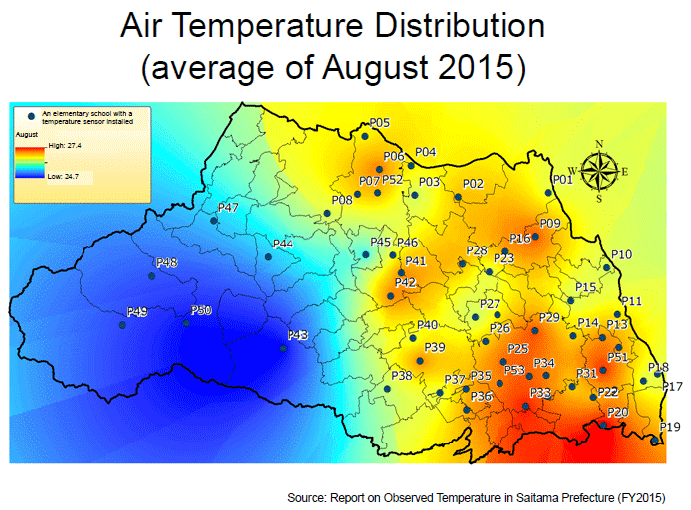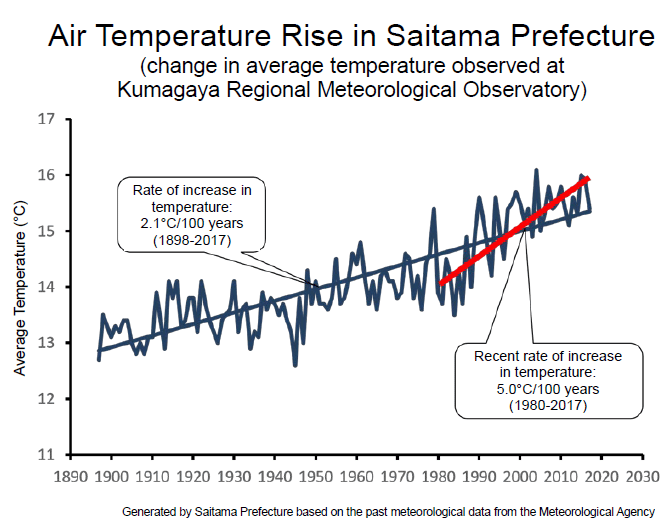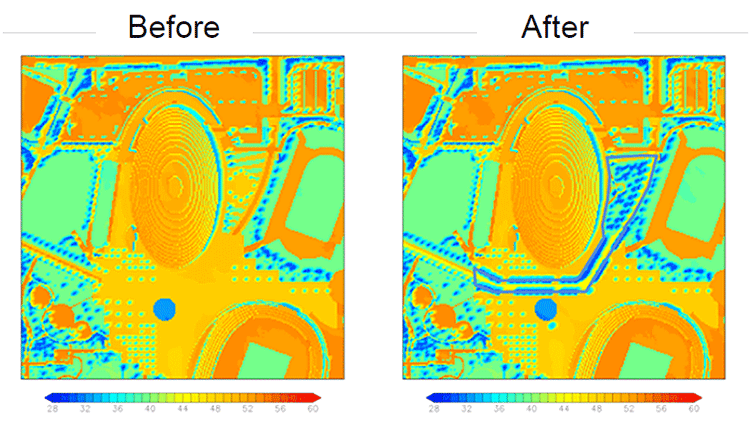Contributing Our Expertise to Prefectural Measures – How an Institution Can Help a Prefecture Implement Measures

Located in Saitama Prefecture, one of the leading municipalities in the climate change efforts across Japan, the Center for Environmental Science in Saitama (CESS) offers scientific support for the prefecture’s policies. In 2008, the CESS launched its own project team to create “Urgent Report: The Impacts of Global Warming on Saitama Prefecture,” asserting the importance of climate change preparedness. The highest priority for Saitama Prefecture is to tackle the problem of summer heat, given that its Kumagaya City marked a record high temperature of 41.1°C on July 23, 2018. The CESS contributes to the prefecture in optimizing the effects of the measures by offering a scientific analysis of the impacts of rising temperatures and the effects of the countermeasure. We interviewed with Tomohide Shimada, Associate Director of Research Promotion Office at CESS; Masayuki Hara, a researcher in charge of Global Warming Mitigation and Adaptation Group at CESS ; and Kentaro Kobayashi, Group Manager of the Global Warming Strategy Division at Saitama Prefecture’s Department of Environment.
Supporting Prefectural Measures as a Research Institute
Please tell us how the CESS contributes to Saitama Prefecture in its climate adaptation strategy.
Shimada: The history of the CESS goes back to 1970s, when its forerunner, the Saitama Prefecture Pollution Center, was established. The highest priority at that time was pollution control measures, including air pollution and water contamination. With the increased importance of global environmental issues, such as global warming control and biodiversity conservation, the current CESS was established in April 2000. In the wake of National Government’s 2008 report “Global Warming - Impacts on Japan,” the CESS launched a cross-sectoral project team in the same year and published “Urgent Report: The Impacts of Global Warming on Saitama Prefecture.” This prompted the creation of a position in charge of global warming strategy in 2010. We invited a climate researcher Hara because we wanted to enhance our climate change strategy.
Hara: I believe that municipalities have the responsibility to provide people with accurate climate information. My original field of research is weather and climate, but I’m currently helping the government implement climate change measures based on accurate scientific information. In addition to offering Saitama Prefecture advice on its measures, I am involved in visiting lectures in an effort to raise public awareness in the prefecture. The CESS provides about 100 visiting lectures annually. Of these, about 10 of them are on the topic of climate change, and the number is gradually increasing. When I give lectures, I try to remember to use plain language so that it’s easy for participants to understand.
In the wake of the June 2018 Climate Change Adaptation Act, it is planned that each municipality will have the regional climate change adaptation centers as a base to collect and provide local information on adaptation. What role do you think this center should play as a prefectural institute?
Shimada: This legislation will work as a major dynamic toward the mainstreaming of adaptation for municipalities. It is critical to establish a collaborative relationship between the government and the local institutes/universities to promote adaptation regionally. I think this requires the regional climate change adaptation centers to digest highly specialized scientific knowledge and provide information to the public. To continually promote adaptation, municipalities and the regional climate change adaptation centers need to work closely together to enforce implementation of measures.
Actively Tackling Summer Heat
What types of adaptation measures are Saitama Prefecture currently working on?
Kobayashi: First of all, we implement measures to control the summer heat. The heat problem needs urgent attention, especially since Kumagaya City marked a record high temperature of 41.1°C on July 23, 2018. Because Saitama Prefecture is inland terrain that is less likely to attract cooler sea breezes and because of the foehn phenomenon caused by winds from mountains in the northwest, the area is susceptible to high temperatures. With support from 50 elementary schools in the prefecture, the CESS has installed air temperature sensors in instrument shelters in schoolyards to collect granular temperature data in each area. The observation results from this data show that the heat is evident, especially in urban areas in eastern Saitama. Also, the annual average temperature observed at the Kumagaya Regional Meteorological Observatory has increased about 2°C from 1898 to 2017, due partly to global warming resulting from increased greenhouse gas emissions. The rise in air temperature is particularly striking over the last 37 years from 1980 to 2017, with an alarming rate equivalent to about 5.0°C per 100 years.

Figure of temperature distribution

Change in average temperature observed at Kumagaya Regional Meteorological Observatory
Hara: Air temperature projection is important for tackling summer heat. We analyzed the future air temperature rise in the prefecture using the projected by the Ministry of the Environment as a reference. The results show that the temperature will rise by 2.0 to 4.8ºC by the end of this century compared to the end of 21st century. This means that if the temperature continues to rise at this rate, the climate of Saitama Prefecture (current average temperature: 15.0ºC) will become warmer, like a southern climate. Over the past several years in Saitama Prefecture, about 3,000 people each year suffered heatstroke and were taken to the hospital by ambulance, and the share of elderly people in this group is growing. Although Saitama Prefecture has a comparatively high younger population, the government should develop strategies for this issue before the situation gets worse.

Are there any specific strategies for the summer heat?
Kobayashi: We designate supermarkets, financial institutions, and convenience stores as temporary evacuation sites or heatstroke information centers, allowing citizens to use them as a “Cool City Oasis”. We’ve asked for cool-looking blue stickers and posters to be posted in easily visible locations. Since we started this effort in 2011, the number of cooperative facilities grew to 6604 at the end of FY2017. Saitama Prefecture is also committed to a three-year project, starting in FY2016, in the aim of developing heat-island-ready residential areas. The project offers subsidies for up to half of the expense of heat-island-ready design in housing development that meets specific conditions, such as strategic block planning with consideration for wind flow, pavement with reduced thermal storage, and residential design with excellent insulation. The project has been well received by residents, so we would like to continue it as a model for summer heat-ready city development.
Hara: Air temperature rise means more than feeling hot and physically uncomfortable. In 2010 and 2012, high temperatures caused a disease in Saitama’s most renowned variety of rice, sai no kagayaki, which caused the core of the rice grain to become white. We need to take action, starting from whatever we can do, because increased temperatures have considerable impacts on human health, disasters, and industries.
For the heat problem, what kinds of actions do you focus on specifically?
Shimada: We are focusing on tackling the heat problem at Kumagaya Sports & Culture-PARK, a prefectural facility. The park has futsal and tennis courts at Sainokuni Kumagaya Dome, an athletic field, and other sports areas, and it attracts 700,000 visitors a year. The Rugby World Cup 2019 will be held at the park’s Kumagaya Rugby Ground, so in preparation, the Park Stadium Division of the City Development Department is directing the measures, including greening and heat insulation pavement.
Hara: We started implementing the measures to address the summer heat problem at Kumagaya Sports & Culture-PARK in FY2016. We received support from the Japan Agency for Marine-Earth Science and Technology (JAMSTEC) to project the midsummer conditions of the 8.2m-wide, 390m-long avenue that leads many visitors to and from sports areas. In this analysis, we needed to collect data on the structures and land use within the park and set conditions such as the wind direction, weather, and time of day. Then, we simulated the road surface under various conditions, including pavement characteristics (highly reflective thermal insulation pavement, water-retaining pavement), the height of trees that provide shade, and planting intervals.

Using the National Research Project for Prefectural Measures
That sounds like an ambitious experiment. Were the simulation results actually used to address the summer heat problem?
Shimada: The simulation was part of the Social Implementation Program on Climate Change Adaptation Technology (SI-CAT) which is led by the Ministry of Education, Culture, Sports, Science and Technology. SI-CAT has a summer heat working group that includes the CESS, JAMSTEC, Nagano Prefecture, Tsukuba University, and Rissho University. The working group decided to conduct a quantitative evaluation of adaptation measures that try to address summer heat, examined the simulation results for Kumagaya Sports & Culture-PARK, and found a certain level of accuracy. Our project was featured in newspapers. With these simulation results, we can explain how summer heat is addressed after implementing the measure quantitatively. The simulation results of several planting patterns showed us the best pattern before the actual work.
Hara: The simulation results also allowed us to understand the quantitative effects of the avenue, small forest oasis, and heat insulation pavement that the prefecture plans to provide for the Kumagaya Sports & Culture-PARK. For example, the simulation found that the temperature in the small forest was reduced by 0.9°C, that the heat stress index (WBGT) was significantly improved, and that the area classified as “Severe Warning” under the heat illness prevention guidelines was reduced by 20%. In addition to quantitative analysis, we used the simulation results to optimize the measures. In a comparison of zigzag and parallel planting patterns for the avenue along the small forest oasis, we found that the zigzag pattern would increase shade by 5%, and so we implemented this planting pattern. Implementing municipal measures that is optimized based on the results of projections and simulations is quite unique across the country.

Ground Surface Temperature from Simulation Before (left) and after (right) the implementation of measures including
planting in zigzag pattern and heat insulation pavement
(Created by JAMSTEC)
CESS is proactively involved in national projects.
Shimada: The implementation of measures to address the summer heat at Kumagaya Sports & Culture-PARK was under SI-CAT program, but we use the findings of this program to evaluate measures on the prefectural level, such as greening projects and heat island mitigation in blocks. At CESS, we also collect and organize findings from national projects other than SI-CAT and extract data that cover Saitama Prefecture while considering prefectural measures.
Hara: Participating in the national projects enables us to obtain the latest data, including climate change projection, downscaling such data, and impact assessment. This is our biggest motivation for participating the projects. As a recent trend, national projects provide prefectures with the findings and data from the research to use in prefectural policy making. While SI-CAT provides us an opportunity for joint research to project the number of heatstroke patients taken to the hospital in Saitama Prefecture, the regional adaptation consortium led by the Ministry of the Environment allows us to explore how we can use the projection method in the SI-CAT for Saitama City. CESS is doing its best to serve as a mediator between the prefecture and the national government by making good use of the scientific findings from the national projects for prefectural measures.
For the Prefecture, With the Prefecture
What kind of commitment do you two bring to your work for the prefectural institution?
Hara: I came to Saitama Prefecture because I believe that municipalities need a person who can read and share climate information correctly in easy-to-understand manner. I previously belonged to an institution and was involved in S-8 and other national projects, but I realized that the project findings are being implemented by municipalities. Now I’m going about my everyday work with the hope of helping these practitioners understand the climate information and utilize the data. I switched my background from a research to implementation in a municipality, and I’ve been involved in the Saitama’s heat island projects through evaluation of the measures, and observation. In this process, I try to find as many opportunities as I can to share my climate knowledge with the officials in charge. This kind of cooperative work with the prefecture makes me feel like my knowledge is useful, which is extremely rewarding.
Shimada: There is a development-restricted green space called Minuma Tambo in the central part of the prefecture. It’s a vast space, with an area of 1,260 ha, and I often think that it could play a substantial role in reducing summer heat effect in urban areas. Personally, I would like to have the opportunity to experiment with a model to prove the importance of green space. While it takes significant time and effort to reduce air temperature, I think it is important to create pleasant spaces. In the future, we will need to incorporate climate change adaptation into measures for social problems, such as aging infrastructure, and take an integrated approach to considering these problems. As a prefectural institution, we would like to accumulate expertise to promote adaptation and continually contribute to the prefecture as an exclusive consultant that searches together for the best method of implementation.


(Published on September 5, 2018)

